 Image 1 of 52
Image 1 of 52

 Image 2 of 52
Image 2 of 52

 Image 3 of 52
Image 3 of 52

 Image 4 of 52
Image 4 of 52

 Image 5 of 52
Image 5 of 52

 Image 6 of 52
Image 6 of 52

 Image 7 of 52
Image 7 of 52

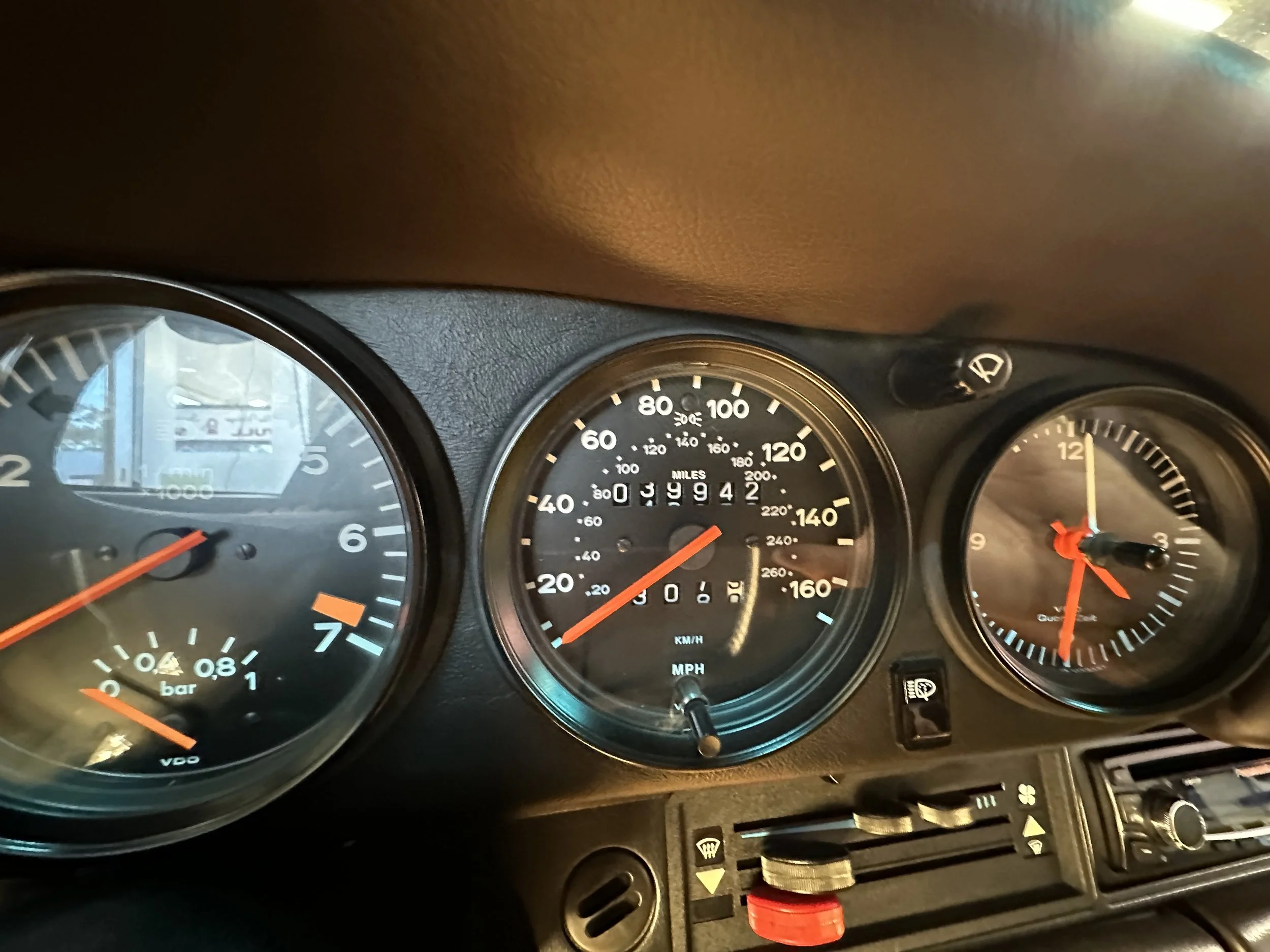 Image 8 of 52
Image 8 of 52

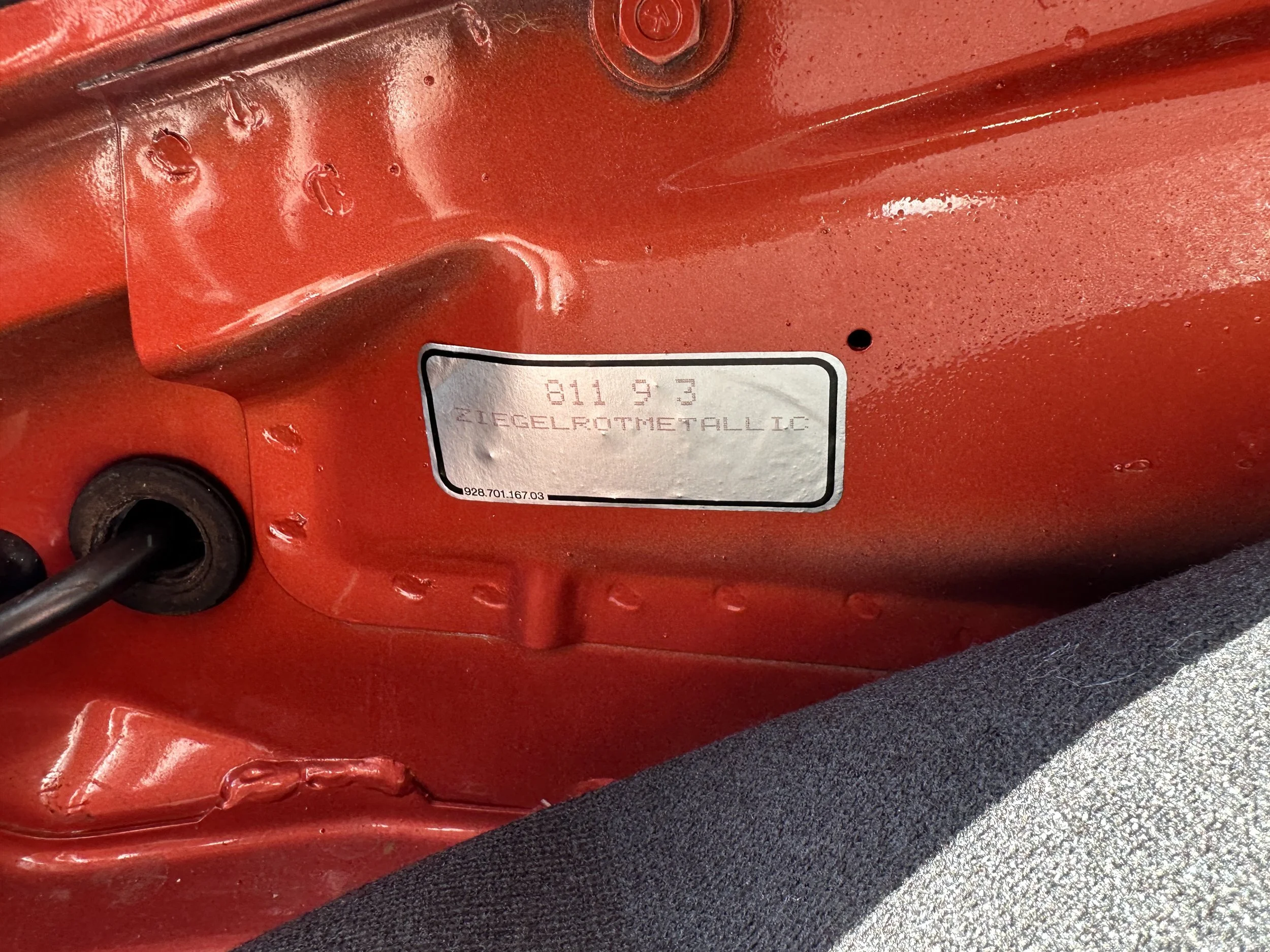 Image 9 of 52
Image 9 of 52

 Image 10 of 52
Image 10 of 52

 Image 11 of 52
Image 11 of 52

 Image 12 of 52
Image 12 of 52

 Image 13 of 52
Image 13 of 52

 Image 14 of 52
Image 14 of 52

 Image 15 of 52
Image 15 of 52

 Image 16 of 52
Image 16 of 52

 Image 17 of 52
Image 17 of 52

 Image 18 of 52
Image 18 of 52

 Image 19 of 52
Image 19 of 52

 Image 20 of 52
Image 20 of 52

 Image 21 of 52
Image 21 of 52

 Image 22 of 52
Image 22 of 52

 Image 23 of 52
Image 23 of 52

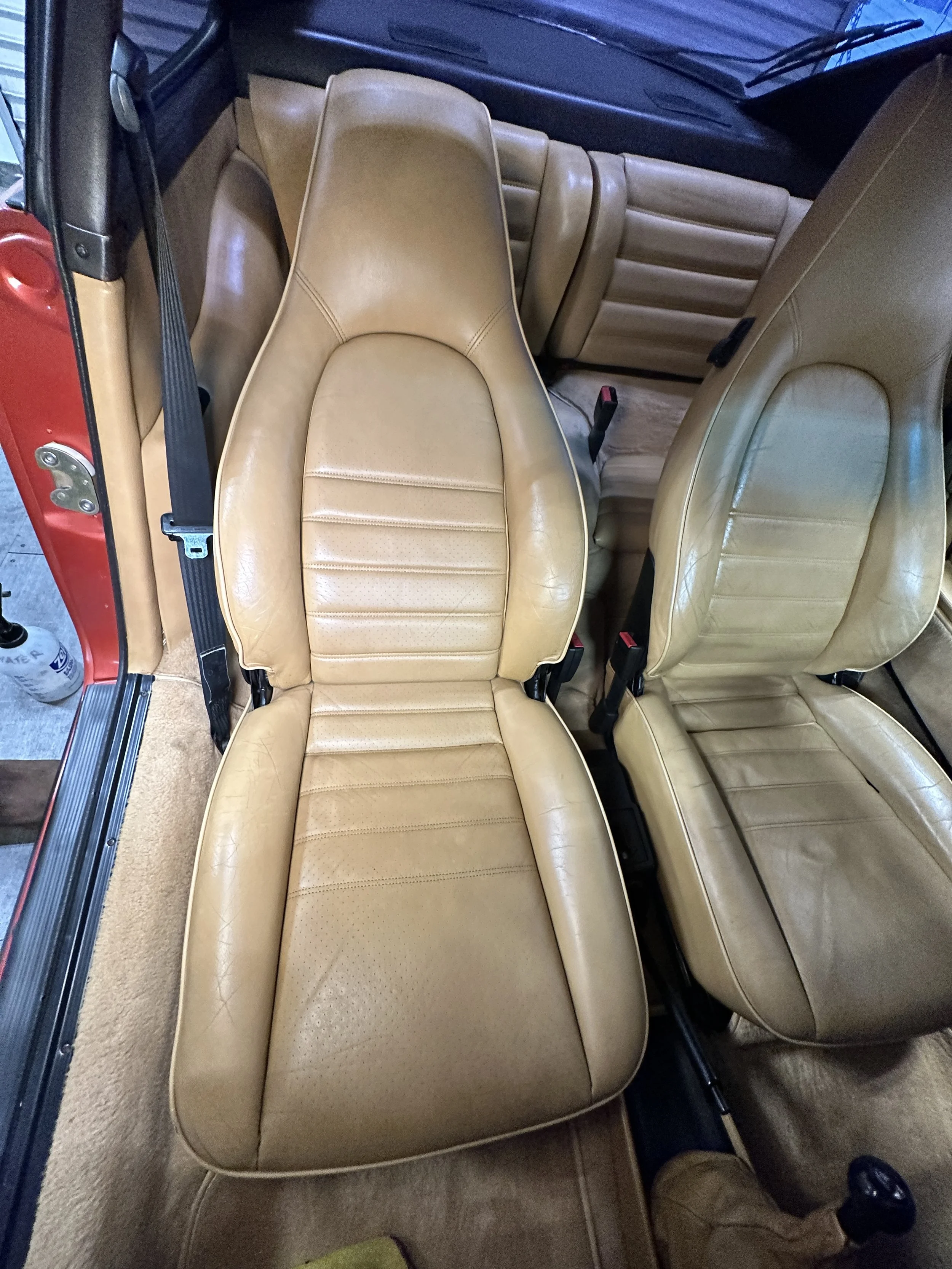 Image 24 of 52
Image 24 of 52

 Image 25 of 52
Image 25 of 52

 Image 26 of 52
Image 26 of 52

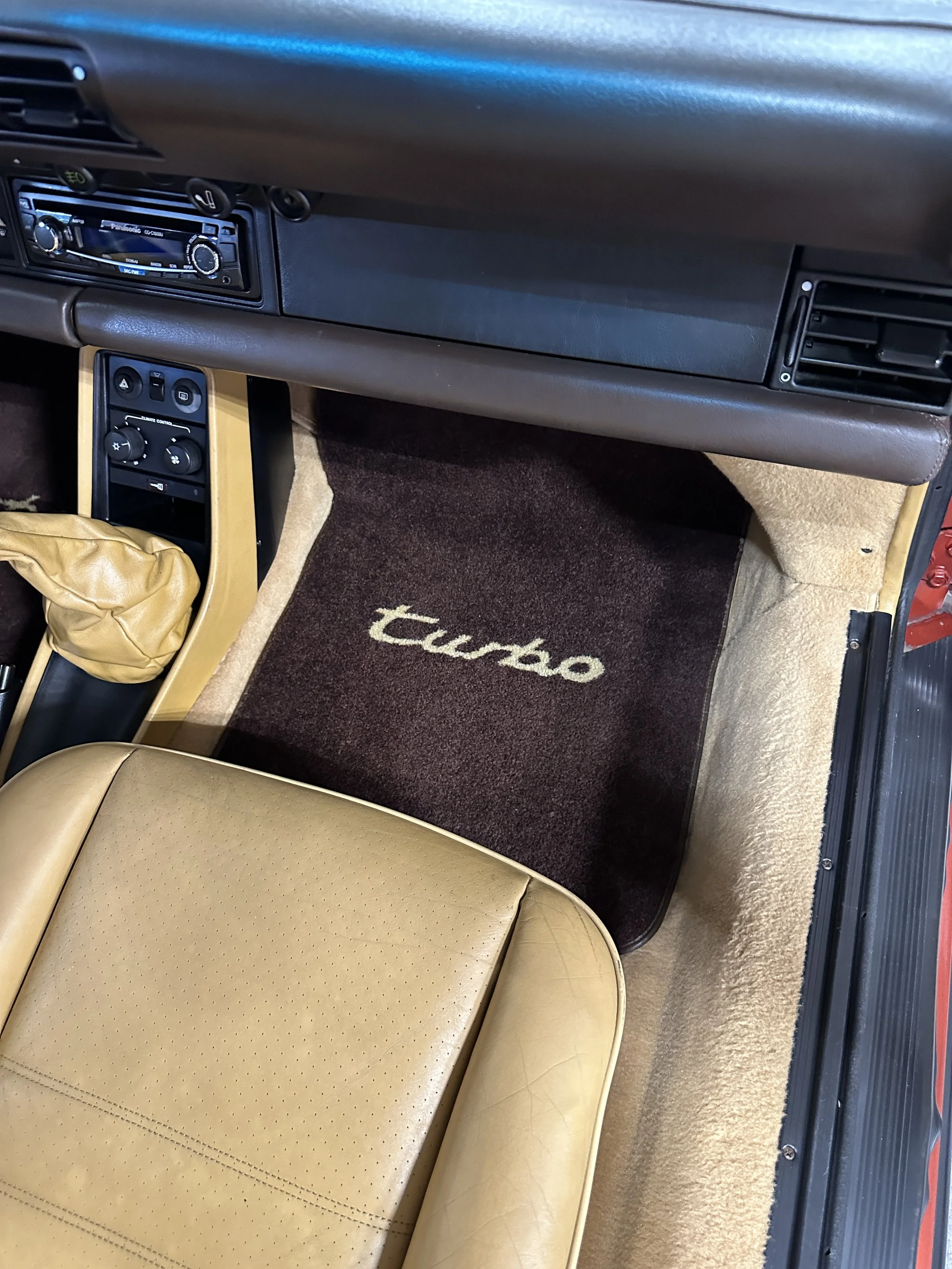 Image 27 of 52
Image 27 of 52

 Image 28 of 52
Image 28 of 52

 Image 29 of 52
Image 29 of 52

 Image 30 of 52
Image 30 of 52

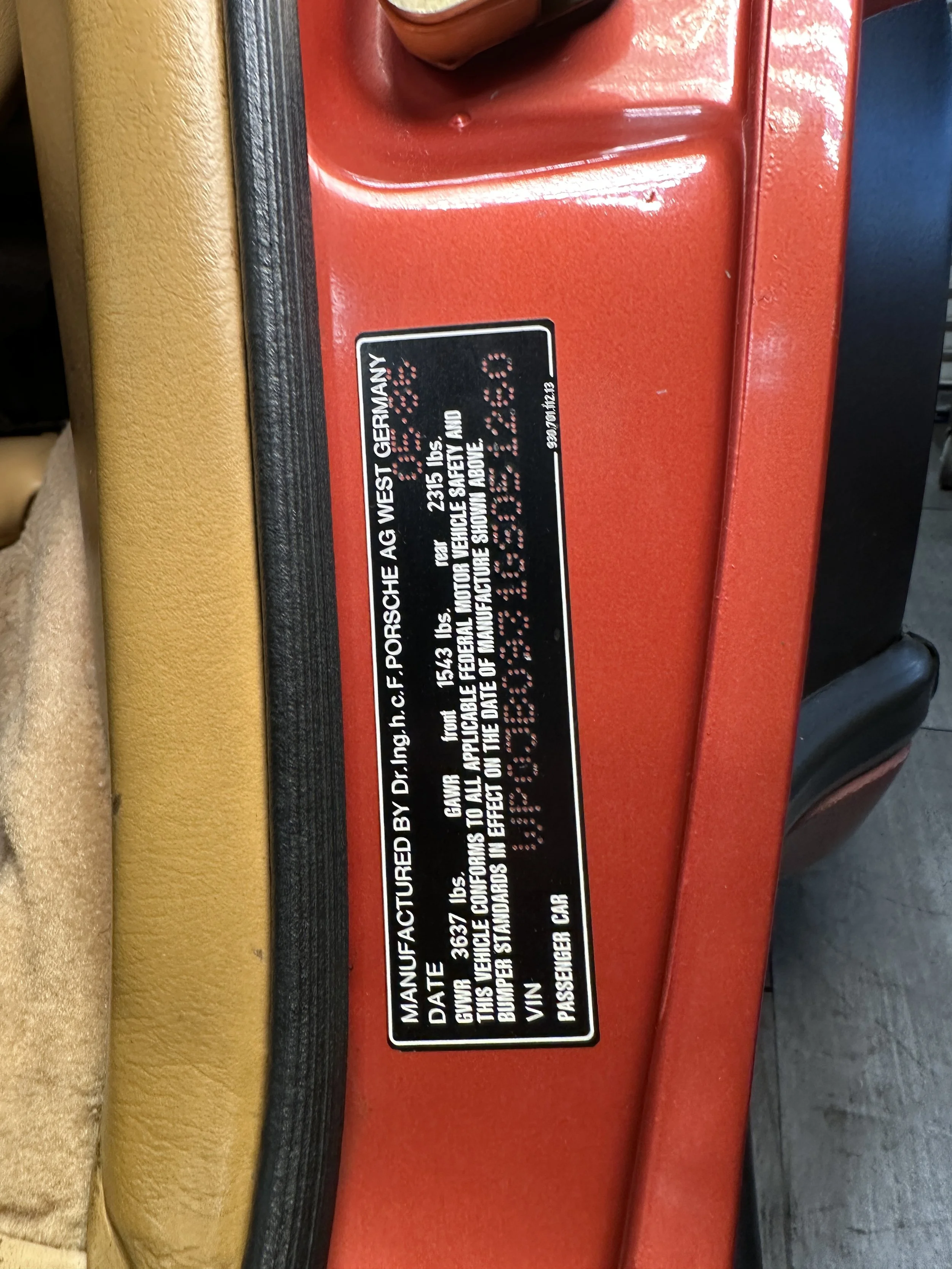 Image 31 of 52
Image 31 of 52

 Image 32 of 52
Image 32 of 52

 Image 33 of 52
Image 33 of 52

 Image 34 of 52
Image 34 of 52

 Image 35 of 52
Image 35 of 52

 Image 36 of 52
Image 36 of 52

 Image 37 of 52
Image 37 of 52

 Image 38 of 52
Image 38 of 52

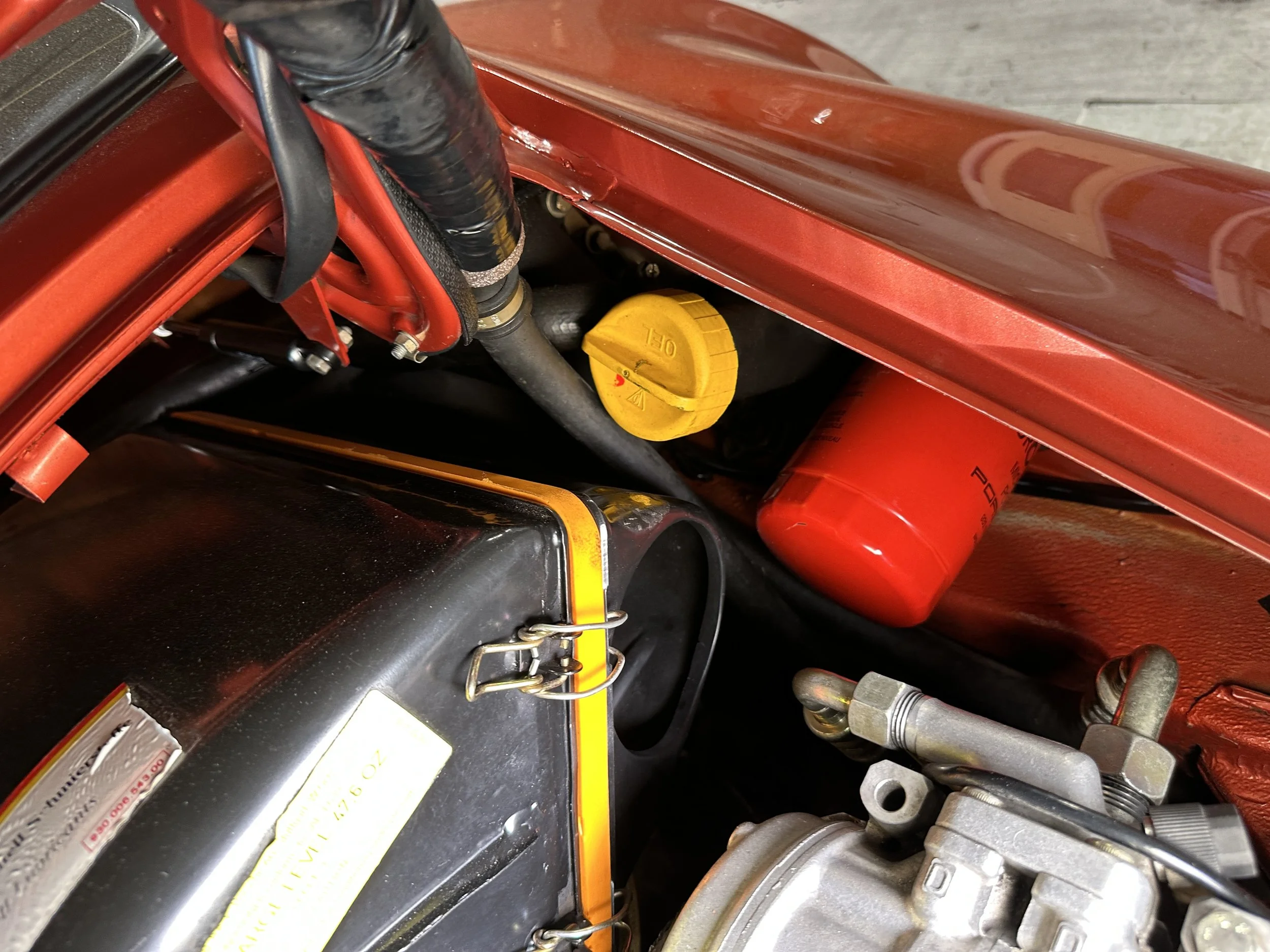 Image 39 of 52
Image 39 of 52

 Image 40 of 52
Image 40 of 52

 Image 41 of 52
Image 41 of 52

 Image 42 of 52
Image 42 of 52

 Image 43 of 52
Image 43 of 52

 Image 44 of 52
Image 44 of 52

 Image 45 of 52
Image 45 of 52

 Image 46 of 52
Image 46 of 52

 Image 47 of 52
Image 47 of 52

 Image 48 of 52
Image 48 of 52

 Image 49 of 52
Image 49 of 52

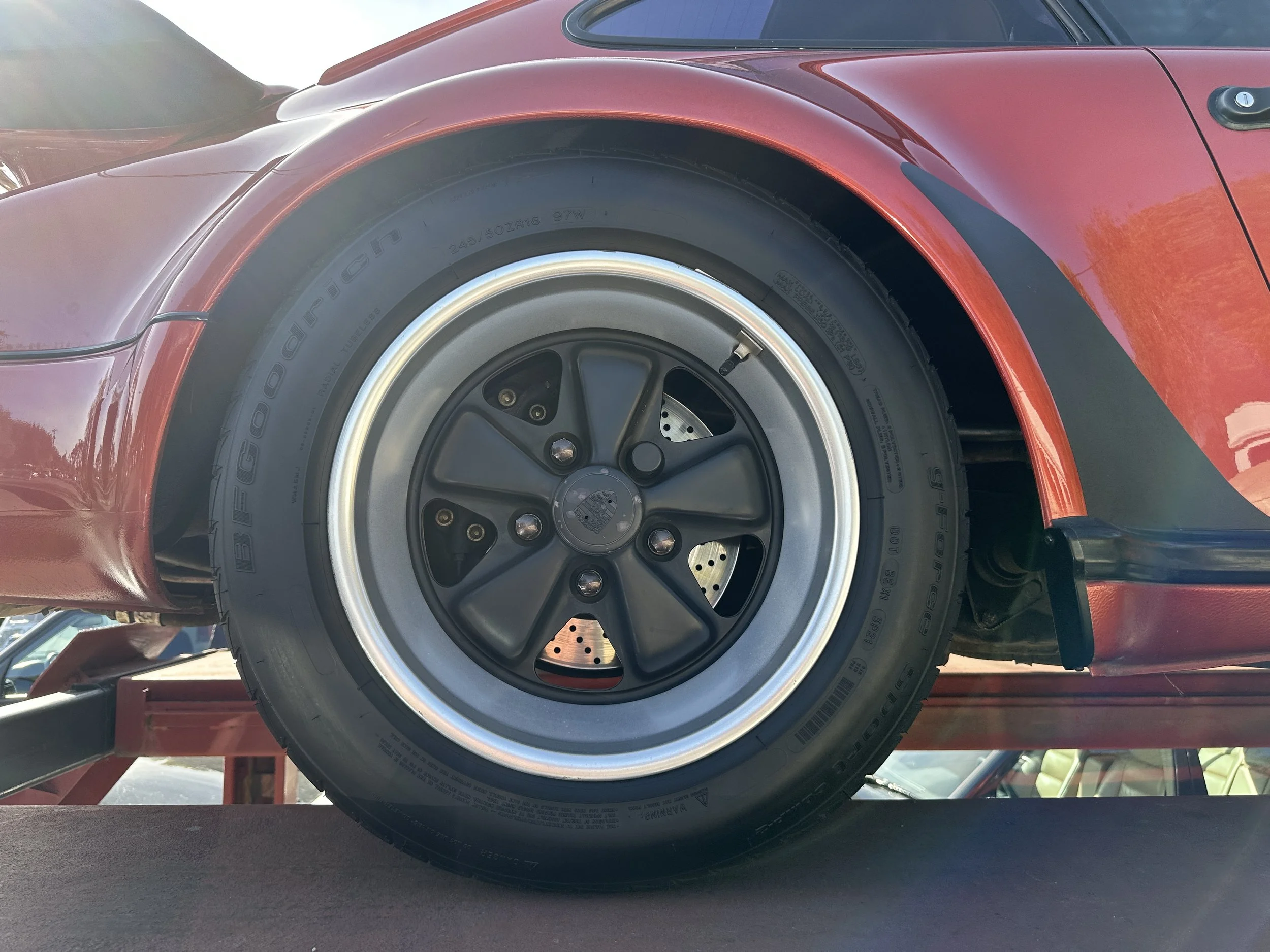 Image 50 of 52
Image 50 of 52

 Image 51 of 52
Image 51 of 52

 Image 52 of 52
Image 52 of 52





















































SOLD! 1986 Porsche 930 Turbo
Presenting a rare and unique 1986 Porsche 930 Turbo. This 2 owner, 39,xxx mile car was ordered new in Visalia California by a local Bank President and was sold to the current owner(s) in 2009. Factory Paint to Sample color in Kiln Red metallic makes this 930 incredibly rare. The color was a factory option in earlier years when the 930 wasn't available in the US. Champagne leather interior with matching carpet and factory "turbo" floor mats. It was ordered with the Limited Slip differential, and no other factory or aftermarket upgrades or modifications were performed. No accidents reported and other than a respray of the paint(see paint meter readings) this car is all factory original, including Power windows, Air conditioning, Sunroof, foglights. Paint and rubber on the car are all in excellent shape. Interior is also excellent, save some creasing on the seats which is typical. As a family owned and driven car, overall the vehicle is in excellent quality (some blemishes not withstanding. see detailed photos). Recent services totaling over $7k by Schneider Autohaus- Santa Barbara's local Porsche service expert, have this car running in tip top condition. Instant cold starts. Car has received a full inspection and has some service records available.
For more Photos, videos and info please got to: https://drive.google.com/file/d/1W27jR1R5iZ98e1tDFuQCqG4t1er07j2-/view?usp=sharing
This special car is being offered for sale by the owner, with the permission of her daughters who sadly lost their husband and father to a battle with cancer some years ago. They have finally all agreed to part ways with his prized Porsche, the last in a collection of many.
Unfortunately the records have been misplaced over the years and we have been unable to locate them after a desperate search.
The mileage, PTS, limited ownership and location of this car really sets it apart from any others.
Its truly rare to find any Porsche 930 Turbo, but you’ll never see another one like this available.
No wholesalers please. No trades considered. Worldwide transport available.
Classic Porsche prices are on the rise and this is especially true for iconic versions like the Porsche 930. The Turbo 911, built between 1975 and 1989 was known to the builders and manufacturers as the Porsche 930. The debut of the 911 Turbo was the Paris Auto Show in 1974 and the first cars available for purchase came the following spring in 1975. These cars are part of Porsche’s long and storied legacy and have at least five distinctive features that help contribute to the 930’s status as an icon.
Fun fact: Ernst Fuhrmann adapted the turbo-technology originally developed for the 917/30 CAN-AM car and applied it to the 3.0 litre flat-six used in Carrera RS 3.0, thus creating what Porsche internally dubbed as the 930.
In 1980 the Type 930 was pulled from the US (and Japanese) markets as a result of yet another change in emissions regulations. It remained available on the Canadian and European markets and beginning in 1981 could be special-ordered as a "Flachbau" or "slantnose" edition. Each Flachbau unit was hand-crafted by remodeling the front fenders into 935-style slantnose and stuffed with an upgraded 3.3L engine that produced 330hp. Very few were built as they commanded quite a premium over the cost of a basic 911 Turbo.
It was the maker's top-of-the-range 911 model for its entire production duration and, at the time of its introduction, was the fastest production car available in Germany.
For the 1983 model year a another special-order, 325hp performance option was introduced. Along with the performance upgrade, the package included a 4-pipe exhaust and an additional oil cooler which required a re-designed front spoiler, additional ventilation holes in the rear fenders and modified rockers.
Finally in 1986, the Type 930 was re-introduced to the US and Japanese markets, fitted with a 278hp emission-controlled engine. Coinciding with the reunion of the Porsche Turbo with the American roads was the release of the Targa and Cabriolet versions which were welcomed with both open arms and wallets by Porsche enthusiasts.
The last major revision for the Type 930 came in 1989, which was ironically the last year of production for the model. It was finally equipped with a G50 transmission - the 5-speed manual that many feel should have been incorporated into the initial design back in 1975. Maybe that was just Porsche's way of proving that they could squeeze superior performance out of just 4 gears - because they did.
The big update over the original 930 Turbo was the revised engined. The Type 930/60 saw displacement increase from 2994cc to 3299cc thanks to an increase in Bore from 95 mm to 97 mm which Stroke increased from 70.4mm to 74.4mm. The compression ratio also increased, from 6.5 to 7.0:1 and a larger but lighter turbo unit replaced the outgoing model’s unit.
The big deal in terms of evolution was the the addition of an air-to-air instead of water-to-air intercooler. Other upgrades included enlarged main bearings and new Bosch K-Jetronic fuel-injection and ignition system. Power went from 260 bhp in the old model to 300 bhp in the new model, while torque went from 253 ft lbs to 303 ft lbs. The four-speed gearbox was given new ratios and re-designated Type 930/34.
Performance improved in terms of the sheer numbers. Compared to the outgoing variant, the 3.3-litre Turbo was 7mph faster (161mph) and 0.6 of a second quicker from 0-62mph (5.1 seconds). Weight went from 1195kg to 1300kg and that extra weight largely from the new engine meant that the nature of Turbo changed. It wasn’t as fun and was probably even more dangerous. It may go a long way to explaining why many collectors see the early 930 Turbo 3.0 as the better drivers cars.
The chassis was basically the same, as was the suspension set up. The original Turbo brakes were upgraded to 304mm cross-drilled and ventilated discs with thicker discs (basically from the 917). Wheels were 16 x 7-inches at the front and 16 x 8 at the rear and were Fuchs units made in alloy.
Visually, the new rear spoiler changes to make room for the intercooler meant the wing was larger and flatter with noticeable cooling vents and a thicker surround. Options for the 3.3 included the ability to get a ZF limited-slip differential, rear fog lights, air-conditioning, an electric sunroof and a central console.
1986 MODEL YEAR – G SERIES CARS
For the 1986 model year we got new Bosch LE-Jetronic fuel-injection, 9-inch wide rear wheels (up from 8-inches) and a slightly redesigned dash fascia. The 911 Turbo was re-introduced to the US market after a five year “rest”. 2,670 units were product (over 50% were for the U.S). Turbo SE (Special Equipment, slant-nose, option M506) limited edition available as special order, with a very nice 330 bhp.
The Porsche name is synonymous with speed, design and high performance. The 930 series is no exception. From their inception to the end of production, the Porsche 930s are iconic. It is easy to see why the 930 has become an icon and coveted classic.
Presenting a rare and unique 1986 Porsche 930 Turbo. This 2 owner, 39,xxx mile car was ordered new in Visalia California by a local Bank President and was sold to the current owner(s) in 2009. Factory Paint to Sample color in Kiln Red metallic makes this 930 incredibly rare. The color was a factory option in earlier years when the 930 wasn't available in the US. Champagne leather interior with matching carpet and factory "turbo" floor mats. It was ordered with the Limited Slip differential, and no other factory or aftermarket upgrades or modifications were performed. No accidents reported and other than a respray of the paint(see paint meter readings) this car is all factory original, including Power windows, Air conditioning, Sunroof, foglights. Paint and rubber on the car are all in excellent shape. Interior is also excellent, save some creasing on the seats which is typical. As a family owned and driven car, overall the vehicle is in excellent quality (some blemishes not withstanding. see detailed photos). Recent services totaling over $7k by Schneider Autohaus- Santa Barbara's local Porsche service expert, have this car running in tip top condition. Instant cold starts. Car has received a full inspection and has some service records available.
For more Photos, videos and info please got to: https://drive.google.com/file/d/1W27jR1R5iZ98e1tDFuQCqG4t1er07j2-/view?usp=sharing
This special car is being offered for sale by the owner, with the permission of her daughters who sadly lost their husband and father to a battle with cancer some years ago. They have finally all agreed to part ways with his prized Porsche, the last in a collection of many.
Unfortunately the records have been misplaced over the years and we have been unable to locate them after a desperate search.
The mileage, PTS, limited ownership and location of this car really sets it apart from any others.
Its truly rare to find any Porsche 930 Turbo, but you’ll never see another one like this available.
No wholesalers please. No trades considered. Worldwide transport available.
Classic Porsche prices are on the rise and this is especially true for iconic versions like the Porsche 930. The Turbo 911, built between 1975 and 1989 was known to the builders and manufacturers as the Porsche 930. The debut of the 911 Turbo was the Paris Auto Show in 1974 and the first cars available for purchase came the following spring in 1975. These cars are part of Porsche’s long and storied legacy and have at least five distinctive features that help contribute to the 930’s status as an icon.
Fun fact: Ernst Fuhrmann adapted the turbo-technology originally developed for the 917/30 CAN-AM car and applied it to the 3.0 litre flat-six used in Carrera RS 3.0, thus creating what Porsche internally dubbed as the 930.
In 1980 the Type 930 was pulled from the US (and Japanese) markets as a result of yet another change in emissions regulations. It remained available on the Canadian and European markets and beginning in 1981 could be special-ordered as a "Flachbau" or "slantnose" edition. Each Flachbau unit was hand-crafted by remodeling the front fenders into 935-style slantnose and stuffed with an upgraded 3.3L engine that produced 330hp. Very few were built as they commanded quite a premium over the cost of a basic 911 Turbo.
It was the maker's top-of-the-range 911 model for its entire production duration and, at the time of its introduction, was the fastest production car available in Germany.
For the 1983 model year a another special-order, 325hp performance option was introduced. Along with the performance upgrade, the package included a 4-pipe exhaust and an additional oil cooler which required a re-designed front spoiler, additional ventilation holes in the rear fenders and modified rockers.
Finally in 1986, the Type 930 was re-introduced to the US and Japanese markets, fitted with a 278hp emission-controlled engine. Coinciding with the reunion of the Porsche Turbo with the American roads was the release of the Targa and Cabriolet versions which were welcomed with both open arms and wallets by Porsche enthusiasts.
The last major revision for the Type 930 came in 1989, which was ironically the last year of production for the model. It was finally equipped with a G50 transmission - the 5-speed manual that many feel should have been incorporated into the initial design back in 1975. Maybe that was just Porsche's way of proving that they could squeeze superior performance out of just 4 gears - because they did.
The big update over the original 930 Turbo was the revised engined. The Type 930/60 saw displacement increase from 2994cc to 3299cc thanks to an increase in Bore from 95 mm to 97 mm which Stroke increased from 70.4mm to 74.4mm. The compression ratio also increased, from 6.5 to 7.0:1 and a larger but lighter turbo unit replaced the outgoing model’s unit.
The big deal in terms of evolution was the the addition of an air-to-air instead of water-to-air intercooler. Other upgrades included enlarged main bearings and new Bosch K-Jetronic fuel-injection and ignition system. Power went from 260 bhp in the old model to 300 bhp in the new model, while torque went from 253 ft lbs to 303 ft lbs. The four-speed gearbox was given new ratios and re-designated Type 930/34.
Performance improved in terms of the sheer numbers. Compared to the outgoing variant, the 3.3-litre Turbo was 7mph faster (161mph) and 0.6 of a second quicker from 0-62mph (5.1 seconds). Weight went from 1195kg to 1300kg and that extra weight largely from the new engine meant that the nature of Turbo changed. It wasn’t as fun and was probably even more dangerous. It may go a long way to explaining why many collectors see the early 930 Turbo 3.0 as the better drivers cars.
The chassis was basically the same, as was the suspension set up. The original Turbo brakes were upgraded to 304mm cross-drilled and ventilated discs with thicker discs (basically from the 917). Wheels were 16 x 7-inches at the front and 16 x 8 at the rear and were Fuchs units made in alloy.
Visually, the new rear spoiler changes to make room for the intercooler meant the wing was larger and flatter with noticeable cooling vents and a thicker surround. Options for the 3.3 included the ability to get a ZF limited-slip differential, rear fog lights, air-conditioning, an electric sunroof and a central console.
1986 MODEL YEAR – G SERIES CARS
For the 1986 model year we got new Bosch LE-Jetronic fuel-injection, 9-inch wide rear wheels (up from 8-inches) and a slightly redesigned dash fascia. The 911 Turbo was re-introduced to the US market after a five year “rest”. 2,670 units were product (over 50% were for the U.S). Turbo SE (Special Equipment, slant-nose, option M506) limited edition available as special order, with a very nice 330 bhp.
The Porsche name is synonymous with speed, design and high performance. The 930 series is no exception. From their inception to the end of production, the Porsche 930s are iconic. It is easy to see why the 930 has become an icon and coveted classic.
Presenting a rare and unique 1986 Porsche 930 Turbo. This 2 owner, 39,xxx mile car was ordered new in Visalia California by a local Bank President and was sold to the current owner(s) in 2009. Factory Paint to Sample color in Kiln Red metallic makes this 930 incredibly rare. The color was a factory option in earlier years when the 930 wasn't available in the US. Champagne leather interior with matching carpet and factory "turbo" floor mats. It was ordered with the Limited Slip differential, and no other factory or aftermarket upgrades or modifications were performed. No accidents reported and other than a respray of the paint(see paint meter readings) this car is all factory original, including Power windows, Air conditioning, Sunroof, foglights. Paint and rubber on the car are all in excellent shape. Interior is also excellent, save some creasing on the seats which is typical. As a family owned and driven car, overall the vehicle is in excellent quality (some blemishes not withstanding. see detailed photos). Recent services totaling over $7k by Schneider Autohaus- Santa Barbara's local Porsche service expert, have this car running in tip top condition. Instant cold starts. Car has received a full inspection and has some service records available.
For more Photos, videos and info please got to: https://drive.google.com/file/d/1W27jR1R5iZ98e1tDFuQCqG4t1er07j2-/view?usp=sharing
This special car is being offered for sale by the owner, with the permission of her daughters who sadly lost their husband and father to a battle with cancer some years ago. They have finally all agreed to part ways with his prized Porsche, the last in a collection of many.
Unfortunately the records have been misplaced over the years and we have been unable to locate them after a desperate search.
The mileage, PTS, limited ownership and location of this car really sets it apart from any others.
Its truly rare to find any Porsche 930 Turbo, but you’ll never see another one like this available.
No wholesalers please. No trades considered. Worldwide transport available.
Classic Porsche prices are on the rise and this is especially true for iconic versions like the Porsche 930. The Turbo 911, built between 1975 and 1989 was known to the builders and manufacturers as the Porsche 930. The debut of the 911 Turbo was the Paris Auto Show in 1974 and the first cars available for purchase came the following spring in 1975. These cars are part of Porsche’s long and storied legacy and have at least five distinctive features that help contribute to the 930’s status as an icon.
Fun fact: Ernst Fuhrmann adapted the turbo-technology originally developed for the 917/30 CAN-AM car and applied it to the 3.0 litre flat-six used in Carrera RS 3.0, thus creating what Porsche internally dubbed as the 930.
In 1980 the Type 930 was pulled from the US (and Japanese) markets as a result of yet another change in emissions regulations. It remained available on the Canadian and European markets and beginning in 1981 could be special-ordered as a "Flachbau" or "slantnose" edition. Each Flachbau unit was hand-crafted by remodeling the front fenders into 935-style slantnose and stuffed with an upgraded 3.3L engine that produced 330hp. Very few were built as they commanded quite a premium over the cost of a basic 911 Turbo.
It was the maker's top-of-the-range 911 model for its entire production duration and, at the time of its introduction, was the fastest production car available in Germany.
For the 1983 model year a another special-order, 325hp performance option was introduced. Along with the performance upgrade, the package included a 4-pipe exhaust and an additional oil cooler which required a re-designed front spoiler, additional ventilation holes in the rear fenders and modified rockers.
Finally in 1986, the Type 930 was re-introduced to the US and Japanese markets, fitted with a 278hp emission-controlled engine. Coinciding with the reunion of the Porsche Turbo with the American roads was the release of the Targa and Cabriolet versions which were welcomed with both open arms and wallets by Porsche enthusiasts.
The last major revision for the Type 930 came in 1989, which was ironically the last year of production for the model. It was finally equipped with a G50 transmission - the 5-speed manual that many feel should have been incorporated into the initial design back in 1975. Maybe that was just Porsche's way of proving that they could squeeze superior performance out of just 4 gears - because they did.
The big update over the original 930 Turbo was the revised engined. The Type 930/60 saw displacement increase from 2994cc to 3299cc thanks to an increase in Bore from 95 mm to 97 mm which Stroke increased from 70.4mm to 74.4mm. The compression ratio also increased, from 6.5 to 7.0:1 and a larger but lighter turbo unit replaced the outgoing model’s unit.
The big deal in terms of evolution was the the addition of an air-to-air instead of water-to-air intercooler. Other upgrades included enlarged main bearings and new Bosch K-Jetronic fuel-injection and ignition system. Power went from 260 bhp in the old model to 300 bhp in the new model, while torque went from 253 ft lbs to 303 ft lbs. The four-speed gearbox was given new ratios and re-designated Type 930/34.
Performance improved in terms of the sheer numbers. Compared to the outgoing variant, the 3.3-litre Turbo was 7mph faster (161mph) and 0.6 of a second quicker from 0-62mph (5.1 seconds). Weight went from 1195kg to 1300kg and that extra weight largely from the new engine meant that the nature of Turbo changed. It wasn’t as fun and was probably even more dangerous. It may go a long way to explaining why many collectors see the early 930 Turbo 3.0 as the better drivers cars.
The chassis was basically the same, as was the suspension set up. The original Turbo brakes were upgraded to 304mm cross-drilled and ventilated discs with thicker discs (basically from the 917). Wheels were 16 x 7-inches at the front and 16 x 8 at the rear and were Fuchs units made in alloy.
Visually, the new rear spoiler changes to make room for the intercooler meant the wing was larger and flatter with noticeable cooling vents and a thicker surround. Options for the 3.3 included the ability to get a ZF limited-slip differential, rear fog lights, air-conditioning, an electric sunroof and a central console.
1986 MODEL YEAR – G SERIES CARS
For the 1986 model year we got new Bosch LE-Jetronic fuel-injection, 9-inch wide rear wheels (up from 8-inches) and a slightly redesigned dash fascia. The 911 Turbo was re-introduced to the US market after a five year “rest”. 2,670 units were product (over 50% were for the U.S). Turbo SE (Special Equipment, slant-nose, option M506) limited edition available as special order, with a very nice 330 bhp.
The Porsche name is synonymous with speed, design and high performance. The 930 series is no exception. From their inception to the end of production, the Porsche 930s are iconic. It is easy to see why the 930 has become an icon and coveted classic.
